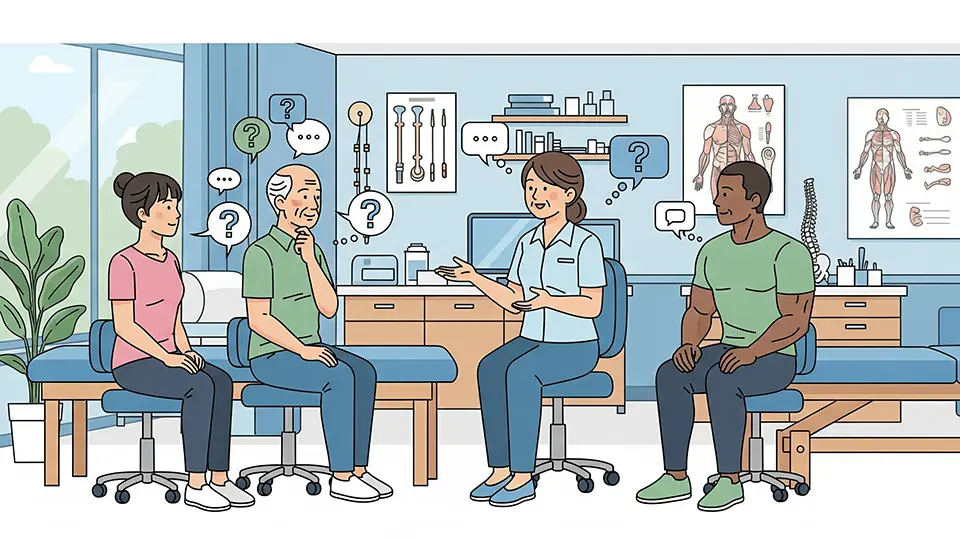Physiotherapy FAQs: Expert Answers to Common Questions
Physiotherapy, also known as physical therapy, plays a vital role in restoring movement and function when someone is affected by injury, illness, or disability. Yet, many people still have questions about what physiotherapy entails, how it works, and whether it’s right for them. This guide answers the most common and trending questions people have about physiotherapy in 2025.
If you’re searching for physiotherapy in Rawalpindi, Islamabad, or beyond, these expert insights will guide you through every step of your rehab journey.
General Questions About Physiotherapy

What is physiotherapy?
Physiotherapy, also known as physical therapy, is a healthcare profession focused on evaluating, diagnosing, and treating physical impairments and mobility limitations. It helps patients restore movement, reduce pain, prevent future injuries, and improve quality of life using physical methods like exercise, manual therapy, and modalities (e.g., ultrasound, electrical stimulation).
Who needs physiotherapy?
Physiotherapy is beneficial for:
- People with sports injuries (e.g., sprains, strains)
- Post-surgical patients (e.g., knee replacement)
- Stroke survivors and neurological conditions
- Seniors with balance or mobility issues
- Office workers with posture-related pain
People with chronic pain conditions (e.g., arthritis, sciatica)
Is a referral required to see a physiotherapist?
In most countries, including Pakistan, a referral is not necessary. You can directly book an appointment with a licensed physiotherapist. However, some insurance providers may require a doctor’s referral for reimbursement purposes.
What should I expect during my first visit?
Your first session will typically include:
- A thorough medical history review
- Physical assessment of strength, flexibility, and range of motion
- Diagnosis and treatment plan discussion
- Initial therapy, such as light exercises or pain relief techniques
Wear comfortable clothing and bring medical reports, if any.
Are physiotherapists doctors?
Physiotherapists are not medical doctors (MDs), but they are licensed healthcare professionals with a Doctor of Physical Therapy (DPT) degree in many countries like the USA. In Pakistan and other countries, they may hold a Doctor of Physiotherapy (DPT) or a Bachelor’s degree with relevant certifications.
How physiotherapy works?
Physiotherapy works by using manual therapy, exercise prescription, education, and electrotherapy to restore function, reduce pain, and prevent future injury. It focuses on treating the root cause of the problem rather than just masking symptoms.
When did physiotherapy start?
Physiotherapy as a formal profession began during World War I to rehabilitate injured soldiers. However, historical evidence suggests physical therapy techniques date back to ancient Greece, where Hippocrates advocated massage and hydrotherapy.
Where does physiotherapy work?
Physiotherapy works in hospitals, clinics, rehabilitation centers, sports facilities, elderly care homes, and even in-home settings. It also extends to virtual/online platforms now through tele-rehabilitation.
Which physiotherapy is best?
The “best” physiotherapy depends on your condition. For orthopedic issues, musculoskeletal physiotherapy is best. For post-stroke rehab, neurological physiotherapy is ideal. Cardiorespiratory and pediatric physiotherapy are best for heart/lung conditions and children respectively.
Who provides physiotherapy jobs?
Physiotherapy jobs are available in hospitals, private clinics, sports teams, rehabilitation centers, research institutes, and academic settings. You can also work as a freelance or online therapist.
Why is physiotherapy important?
Physiotherapy is essential because it helps:
Restore physical function
Manage chronic pain
Improve mobility and independence
Prevent injuries
Avoid surgery in many cases
Will physiotherapy help sciatica?
Yes, physiotherapy is one of the most recommended treatments for sciatica. It includes stretching exercises, core strengthening, postural correction, and manual techniques to relieve nerve compression.
Can physiotherapy help GERD?
Though GERD is a digestive issue, physiotherapy can indirectly help by improving posture and breathing patterns which may reduce symptoms. Diaphragmatic breathing and thoracic mobility exercises are sometimes recommended.
Cost & Insurance Questions about Physiotherapy

How much does physiotherapy cost in the US?
The average out-of-pocket cost per physiotherapy session in the US ranges from $75 to $350, depending on location and treatment type.
How much is 2 months of physical therapy?
Assuming 2–3 sessions per week, two months of therapy could cost between $1,200 and $3,000 without insurance.
How much does physiotherapy cost in Rawalpindi or Islamabad?
Physiotherapy costs vary based on clinic and specialty. Average rates:
- Initial Assessment: PKR 2000–3000
- Follow-up sessions: PKR 1500–2500
- Specialized treatments (e.g. chiropractic care, dry needling): PKR 2000–3000
What is the average cost of a physiotherapy session?
Globally, it varies. In the US: $100–$150/session. In Pakistan: PKR 1,500–4,000/session
How to find out if insurance covers physical therapy?
Contact your insurance provider
Check your plan’s benefits section
Ask your physiotherapy clinic—they often verify insurance coverage for you
Is physical therapy free with insurance?
Not entirely. Most insurance plans cover PT partially after you meet the deductible. You may still pay co-pays or coinsurance.
Does insurance limit physical therapy sessions?
Yes, most plans have annual session limits (e.g., 20–30 visits per year), unless medical necessity is proven.
How long will insurance pay for physical therapy?
Insurance typically covers PT until you’ve met the session limit or recovery goals are achieved. Some extend coverage with physician re-evaluation.
Physiotherapy without insurance?
Many clinics offer discounted cash packages or sliding-scale fees. Community rehab centers or teaching hospitals may also provide affordable services.
How do I find a qualified physiotherapist near me?
Look for:
- Certification from a recognized institute (e.g., Mayo, Ripha, KEMU, GC)
- Reviews on Google
- Clean facility and proper equipment
- Personalized treatment approach
If you’re in Rawalpindi or Islamabad, clinics like Dr Iqra Kiran, Physical Therapist, Physio Rehab Solution offer expert physiotherapy care with licensed practitioners.
Physiotherapy near me / Physiotherapy clinic near me
If you are based in Rawalpindi or Islamabad, you can visit reputable clinics such as:
Dr Iqra Kiran, Physical Therapist, Physio Rehab Solution
Career & Education Questions about Physiotherapy

Physiotherapy course
Physiotherapy courses range from diplomas to Bachelor’s and Doctor of Physiotherapy (DPT). Duration is typically 4–5 years. Specializations can be pursued afterward.
Physiotherapy license
To practice legally, physiotherapists must hold a valid license. In the US, this requires passing the NPTE exam. In Pakistan, licensing is governed by the HEC and PMC.
Physiotherapy salary
USA: $90K–$115K/year
UK: £30K–£50K/year
Pakistan: PKR 50K–200K/month depending on experience and location
Physiotherapy like job
Occupational therapist
Chiropractor
Kinesiologist
Athletic trainer
Rehab technician
Treatment-Specific Questions about Physiotherapy

Physiotherapy for dogs?
Yes, animal physiotherapy is a growing field. It helps dogs recover from surgery, manage arthritis, or improve mobility using massage, hydrotherapy, and exercises.
Physiotherapy vs Physical Therapy
There is no difference. “Physiotherapy” is the term used in the UK, Canada, Australia, and Pakistan. “Physical Therapy” is more common in the US. Both terms refer to the same practice.
Physiotherapy exercises for lower back pain
- Pelvic tilts
- Cat-cow stretch
- Glute bridges
- McKenzie extension
- Child’s pose
How long does physiotherapy take to work?
Recovery depends on your condition. For example:
- Acute injuries (e.g., ankle sprain): 2–4 weeks
- Chronic pain (e.g., sciatica): 6–12 weeks
- Post-surgical rehab (e.g., ACL repair): 3–6 months
Consistency and following your home exercise program are key.
Is physiotherapy painful?
Physiotherapy is designed to relieve pain, not cause it. However, some discomfort is common—especially in the beginning—as your body adapts. Your therapist will ensure exercises are safe and within your pain tolerance.
Can physiotherapy help with chronic conditions?
Absolutely. Physiotherapy is proven to manage chronic issues like arthritis, fibromyalgia, and spinal disc problems. It improves joint mobility, muscle strength, and pain tolerance through tailored exercise programs and manual techniques.
What are the most common physiotherapy techniques?
- Manual Therapy (massage, mobilization)
- Therapeutic Exercise (strengthening, stretching)
- Electrotherapy (TENS, ultrasound)
- Dry Needling
- Posture and Ergonomic Training
- Balance and Gait Training
Can physiotherapy help sciatica?
Yes. A physiotherapist will guide you through stretches, nerve glides, and core strengthening exercises to relieve sciatic nerve pressure and reduce inflammation. Manual therapy and posture correction may also help.
Does physiotherapy work for frozen shoulder?
Definitely. A mix of joint mobilization, strengthening, stretching, and ultrasound therapy can help restore range of motion and reduce pain.
Is physiotherapy useful after surgery?
Yes. Post-operative physiotherapy is crucial for:
- Regaining strength and mobility
- Preventing scar tissue build-up
- Reducing swelling
- Improving joint range of motion
Common surgeries needing rehab include knee/hip replacements, rotator cuff repair, and spinal surgery.
Can children benefit from physiotherapy?
Children with delayed milestones, cerebral palsy, or sports injuries can greatly benefit from pediatric physiotherapy. Early intervention improves outcomes.
DIY and Home Care Related Questions about Physiotherapy

Can I do physiotherapy at home?
Yes—many exercises are home-based. Your therapist will usually provide a customized Home Exercise Program (HEP). However, periodic check-ins are necessary to monitor progress and adjust treatment.
What home equipment is helpful for physiotherapy?
Basic equipment includes:
- Resistance bands
- Foam rollers
- Yoga mats
- Light dumbbells
- Stability balls
- Hot/cold packs
Your therapist may also recommend portable TENS machines
What lifestyle changes support physiotherapy?
- Adequate hydration and nutrition
- Regular movement and stretching breaks
- Mindfulness or breathing exercises
- Sleep hygiene
- Ergonomic workspace setup
Final Thoughts
Physiotherapy is more than just exercises—it’s a structured, evidence-based process for restoring your body to full function. Whether you’re struggling with back pain, recovering from an injury, or dealing with a chronic condition, physiotherapy can help you regain control over your body and your life.
Don’t let pain hold you back. Book a consultation today with a licensed physiotherapist in Islamabad or Rawalpindi and take the first step toward recovery.
📢 Call to Action
Looking for expert physiotherapy in Rawalpindi or Islamabad?
✅ Book your initial assessment now and get a customized treatment plan.
📞 Call us at +92-321-428-777-3 | 🌐 Visit: www.physiorehabsolution.com